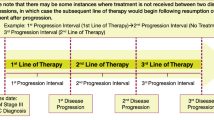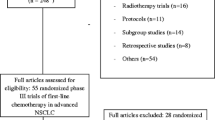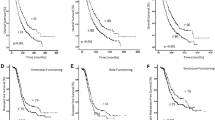Abstract
Purpose
Small cell lung cancer (SCLC) is a highly fatal disease associated with significant morbidity, with a need for real-world symptom and health utility score (HUS) data. HUS can be measured using an EQ-5D-5L questionnaire, however most captured data is available in non-SCLC (NSCLC) only. As new treatment regimens become available in SCLC it becomes important to understand factors which influence health-related quality of life and health utility.
Methods
A prospective observational cohort study (2012–2017) of ambulatory histologically confirmed SCLC evaluated patient-reported EQ-5D-5L-derived HUS, toxicity and symptoms. A set of NSCLC patients was used to compare differential factors affecting HUS. Clinical and demographic factors were evaluated for differential interactions between lung cancer types. Comorbidity scores were documented for each patient.
Results
In 75 SCLC and 150 NSCLC patients, those with SCLC had lower mean HUS ((SCLC vs NSCLC: mean 0.69 vs 0.79); (p < 0.001)) when clinically stable and with progressive disease: ((SCLC mean HUS = 0.60 vs NSCLC mean HUS = 0.77), (p = 0.04)). SCLC patients also had higher comorbidity scores ((1.11 vs 0.73); (p < 0.015)). In multivariable analyses, increased symptom severity and comorbidity scores decreased HUS in both SCLC and NSCLC (p < 0.001); however, only comorbidity scores differentially affected HUS (p < 0.0001), with a greater reduction of HUS adjusted per unit of comorbidity in SCLC.
Conclusion
Patients with advanced SCLC had significantly lower HUS than NSCLC. Both patient cohorts are impacted by symptoms and comorbidity, however, comorbidity had a greater negative effect in SCLC patients.

Similar content being viewed by others
References
Sabari, J. K., Lok, B. H., Laird, J. H., Poirier, J. T., & Rudin, C. M. (2017). Unravelling the biology of SCLC: implications for therapy. Nature Reviews Clinical Oncology, 14(9), 549–561.
Horn, L., Mansfield, A. S., Szczesna, A., Havel, L., Krzakowski, M., Hochmair, M. J., et al. (2018). First-line atezolizumab plus chemotherapy in extensive-stage small-cell lung cancer. The New England Journal of Medicine., 379, 2220–2229.
Yu, J. B., Decker, R. H., Detterbeck, F. C., & Wilson, L. D. (2010). Surveillance epidemiology and end results evaluation of the role of surgery for stage I small cell lung cancer. Journal of Thoracic Oncology, 5(2), 215–219.
Califano, R., Abidin, A. Z., Peck, R., Faivre-Finn, C., & Lorigan, P. (2012). Management of small cell lung cancer: Recent developments for optimal care. Drugs., 72(4), 471–490.
Baldotto, C. S., Cronemberger, E. H., de Biasi, P., Zamboni, M., Sousa, A., Zukin, M., et al. (2012). Palliative care in poor-performance status small cell lung cancer patients: Is there a mandatory role for chemotherapy? Supportive Care in Cancer, 20(11), 2721–2727.
Turrisi, A. T., Kim, K., Blum, R., Sause, W. T., Livingston, R. B., Komaki, R., et al. (1999). Twice-daily compared with once-daily thoracic radiotherapy in limited small-cell lung cancer treated concurrently with cisplatin and etoposide. New England Journal of Medicine, 340(4), 265–271.
Farrell, M. J., Yahya, J. B., Degnin, C., Chen, Y., Holland, J. M., Henderson, M. A., et al. (2018). Prophylactic cranial irradiation for limited-stage small-cell lung cancer: Survey of US radiation oncologists on current practice patterns. Clinical Lung Cancer., 18, 30042–30051.
Rodríguez-de-Dios, C., López, J. L., Calvo, P., Murcia, M., Rico, M., Vallejo, C., et al. (2018). Treatment design and rationale for a randomized trial of prophylactic cranial irradiation with or without hippocampal avoidance for SCLC: PREMER Trial on Behalf of the Oncologic Group for the Study of Lung Cancer/Spanish Radiation Oncology Group-Radiation Oncology Clinical Research Group. Clinical Lung Cancer., 19, e693–e697.
Auperin, A., Arriagada, R., Pignon, J. P., Le Pechoux, C., Gregor, A., Stephens, R. J., et al. (1999). Prophylactic cranial irradiation for patients with small-cell lung cancer in complete remission: Prophylactic Cranial Irradiation Overview Collaborative Group. The New England Journal of Medicine, 341(7), 476–484.
Takahashi, T., Yamamoto, N., Seto, T., Harada, H., Nokihara, H., Saka, H., et al. (2017). Prophylactic cranial irradiation versus observation in patients with extensive-disease small-cell lung cancer: a multicentre, randomised, open-label, phase 3 trial. The Lancet Oncology, 5(18), 663–671.
Verma, V., Choi, J. I., & Simone, C. B. (2018). Proton Therapy for small cell lung cancer. Translational Lung Cancer Research, 2(7), 134–140.
Bryan, M. B., Wells, J. R., Charlotte, P., Yong, Y., & Penrod, J. R. (2017). The humanistic burden of small cell lung cancer (SCLC): A systematic review of health-related quality of life (HRQoL) literature. Front Pharmacol., 8, 339.
Labbe, C., Leung, Y., Silva Lemes, J. G., Stewart, E., Brown, C., Cosio, A. P., et al. (2016). Real-world EQ5D health utility scores for patients with metastatic lung cancer by molecular alteration and response to therapy. Clin Lung Cancer., 18, 388–395.
Weinstein, M. C., Torrance, G., & McGuire, A. (2009). QALYs: The basics. Value Health., 12(Suppl 1), S5–9.
Janssen, M. F., Pickard, A. S., Golicki, D., Gudex, C., Niewada, M., Scalone, L., et al. (2013). Measurement properties of the EQ-5D-5L compared to the EQ-5D-3L across eight patient groups: a multi-country study. Quality of Life Research., 7(22), 1717–1727.
Herdman, M., Gudex, C., Lloyd, A., Janssen, M. F., Kind, P., Parkin, D., et al. (2011). Development and preliminary testing of the new five-level version of EQ-5D (EQ-5D-5L). Quality of Life Research., 10(20), 1727–1736.
Xie, F., Pullenayegum, E., Gaebel, K., Bansback, N., Bryan, S., Ohinmaa, A., et al. (2016). A time trade-off-derived value set of the EQ-5D-5L for Canada. Medical Care, 54(1), 98–105.
Augustovski, F., Rey-Ares, L., Irazola, V., Garay, O. U., Gianneo, O., Fernandez, G., et al. (2016). An EQ-5D-5L value set based on Uruguayan population preferences. Quality of Life Research, 25(2), 323–333.
Devlin, N. J., Shah, K. K., Feng, Y., Mulhern, B., & van Hout, B. (2018). Valuing health-related quality of life: An EQ-5D-5L value set for England. Health Economics, 27(1), 7–22.
Shiroiwa, T., Fukuda, T., Ikeda, S., Igarashi, A., Noto, S., Saito, S., et al. (2016). Japanese population norms for preference-based measures: EQ-5D-3L, EQ-5D-5L, and SF-6D. Quality of Life Research, 25(3), 707–719.
Wu, C., Gong, Y., Wu, J., Zhang, S., Yin, X., Dong, X., et al. (2016). Chinese version of the EQ-5D preference weights: Applicability in a Chinese general population. PLoS ONE, 11(10), e0164334.
Kim, S. H., Ahn, J., Ock, M., Shin, S., Park, J., Luo, N., et al. (2016). The EQ-5D-5L valuation study in Korea. Quality of Life Research, 25(7), 1845–1852.
Chouaid, C. A. J., Goker, E., Herder, G. J., Lester, J. F., Vansteenkiste, J., Finnern, H. W., et al. (2013). Health-related quality of life and utility in patients with advanced non-small-cell lung cancer: A prospective cross-sectional patient survey in a real-world setting. Journal of Thoracic Oncology, 8(8), 997–1003.
Iyer, S., Taylor-Stokes, G., & Roughley, A. (2013). Symptom burden and quality of life in advanced non-small cell lung cancer patients in France and Germany. Lung Cancer., 81(2), 288–293.
Dutkowska, A. E., & Antczak, A. (2016). Comorbidities in lung cancer. Pneumonologia i Alergologia Polska, 84(3), 186–192.
Halvorsen, T. O., Sundstrom, S., Flotten, O., Brustugun, O. T., Brunsvig, P., Aasebo, U., et al. (2016). Comorbidity and outcomes of concurrent chemo- and radiotherapy in limited disease small cell lung cancer. Acta Oncologica, 55(11), 1349–1354.
Kuo, Y. W., Jerng, J. S., Shih, J. Y., Chen, K. Y., Yu, C. J., & Yang, P. C. (2011). The prognostic value of the simplified comorbidity score in the treatment of small cell lung carcinoma. Journal of Thoracic Oncology, 6(2), 378–383.
Aarts, M. J., Aerts, J. G., van den Borne, B. E., Biesma, B., Lemmens, V. E., & Kloover, J. S. (2015). Comorbidity in patients with small-cell lung cancer: Trends and prognostic impact. Clinical Lung Cancer, 16(4), 282–291.
Gronberg, B. H., Sundstrom, S., Kaasa, S., Bremnes, R. M., Flotten, O., Amundsen, T., et al. (2010). Influence of comorbidity on survival, toxicity and health-related quality of life in patients with advanced non-small-cell lung cancer receiving platinum-doublet chemotherapy. European Journal of Cancer, 46(12), 2225–2234.
Feng, Y., Parkin, D., & Devlin, N. J. (2014). Assessing the performance of the EQ-VAS in the NHS PROMs programme. Quality of Life Research, 23(3), 977–989.
Basch, E., Reeve, B. B., & Mitchell, S. A. (2014). Development of the National Cancer Institute's patient-reported outcomes version of the common terminology criteria for adverse events (PRO-CTCAE). Journal of National Cancer Institute, 9(106), dju244.
Lieffers, J. R., Baracos, V. E., & Winget, M. (2011). A comparison of Charlson and Elixhauser comorbidity measures to predict colorectal cancer survival using administrative health data. Cancer, 9(117), 1957–1965.
Habbous, S., Harland, L. T., & La Delfa, A. (2014). Comorbidity and prognosis in head and neck cancers: Differences by subsite, stage, and human papillomavirus status. Head and Neck, 6(36), 802–810.
Charlson, M. E., Pompei, P., Ales, K. L., & MacKenzie, C. R. (1987). A new method of classifying prognostic comorbidity in longitudinal studies: Development and validation. Journal of Chronic Diseases, 40(5), 373–383.
Schneeweiss, S., & Maclure, M. (2000). Use of comorbidity scores for control of confounding in studies using administrative databases. International Journal of Epidemiology, 5(29), 891–898.
Sundararajan, V., Quan, H., & Halfon, P. (2007). Cross-National comparative performance of three versions of the ICD-10 Charlson Index. Medical Care, 45, 1210–1215.
Wolff, H. B., Alberts, L., Kastelijn, E. A., Lissenberg-Witte, B. I., Twisk, J. W., Lagerwaard, F. J., et al. (2018). Differences in longitudinal health utility between stereotactic body radiation therapy and surgery in Stage I non-small cell lung cancer. Journal of Thoracic Oncology, 13(5), 689–698.
Rios, J., Gosain, R., Goulart, B. H., Huang, B., Oechsli, M. N., McDowell, J. K., et al. (2018). Treatment and outcomes of non-small-cell lung cancer patients with high comorbidity. Cancer Management and Research, 10, 167–175.
Chen, J., Qi, Y., Wampfler, J. A., Jatoi, A., Garces, Y. I., Busta, A. J., et al. (2012). Effect of cigarette smoking on quality of life in small cell lung cancer patients. European Journal of Cancer, 48(11), 1593–1601.
Poder, T. G., Carrier, N., McFadden, N., & Pavic, M. (2019). Health Utilities in cancer patients. Medicine (Baltimore)., 98(9), e14647.
Versteegh, M. M., & Brouwer, W. B. F. (2016). Patient and general public preferences for health states: A call to reconsider current guidelines. Social Science & Medicine., 165, 66–74.
Joseph, M. U., Hershman, D. L., Mark, E. F., & Riha, V. (2019). Association of patient comorbid conditions with cancer clinical trial participation. JAMA Oncology., 3(5), 326–333.
Funding
This study received no external funding.
Author information
Authors and Affiliations
Contributions
GOK, GL, AV, SS, WX analyzed and interpreted the data. AV, GL, GOK developed the study design and wrote the manuscript. All authors critically revised the paper. All authors have read and approved the final version of the manuscript.
Corresponding author
Ethics declarations
Conflict of interest
Dr. Liu reports Grants and honoraria from AstraZeneca and Takeda; honoraria from Novartis, AbbVie; and advisory boards from Roche, Pfizer, Merck, Bristol Myers Squibb, and Bayer. The remaining authors have stated that they have no conflicts of interest. We have full control of all primary data and agree to allow the journal to review data if requested.
Ethical approval
Ethics approval was obtained from the institutional research-ethics board of the University Health Network/Princess Margaret Cancer Centre. The University Health Network is the umbrella legal hospital network entity that includes multiple hospitals, including Princess Margaret Cancer Centre, the location where the study was carried out and where the affiliated authors are attached. All procedures performed in studies involving human participants were in accordance with the ethical standards of the institutional and/or national research committee and with the 1964 Helsinki declaration and its later amendments or comparable ethical standards.
Informed consent
Informed written consent was obtained from all participants of the study. All data collected through questionnaires were anonymized and contained no identifying information.
Research involving human participants and/or animals
This study was a retrospective, observational, non-interventional study involving human participants.
Additional information
Publisher's Note
Springer Nature remains neutral with regard to jurisdictional claims in published maps and institutional affiliations.
Electronic supplementary material
Below is the link to the electronic supplementary material.
Rights and permissions
About this article
Cite this article
Vedadi, A., Shakik, S., Brown, M.C. et al. The impact of symptoms and comorbidity on health utility scores and health-related quality of life in small cell lung cancer using real world data. Qual Life Res 30, 445–454 (2021). https://doi.org/10.1007/s11136-020-02615-1
Accepted:
Published:
Issue Date:
DOI: https://doi.org/10.1007/s11136-020-02615-1




